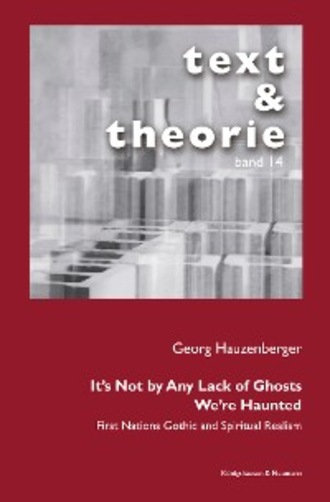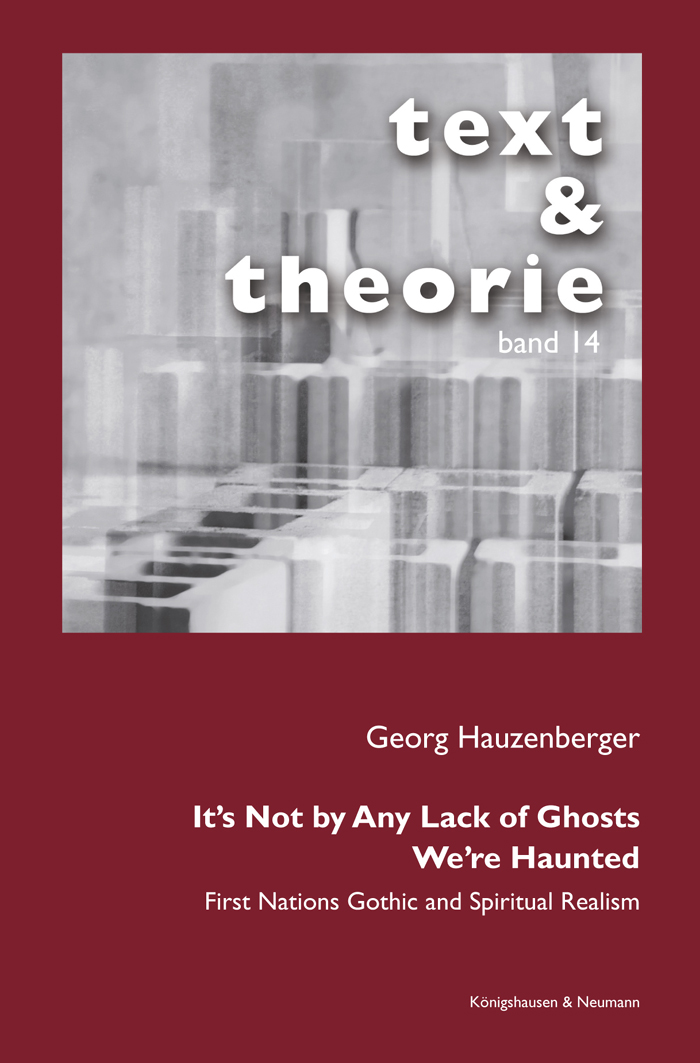
Полная версия
It's Not by Any Lack of Ghosts. We're Haunted.

Hauzenberger

It’s Not by Any Lack of Ghosts
We’re Haunted
text & theorie
herausgegeben von
Martin Middeke und Hubert Zapf
Band 14
Georg Hauzenberger
It’s Not by Any Lack of Ghosts We’re Haunted
First Nations Gothic and Spiritual Realism
Königshausen & Neumann
Bibliografische Information der Deutschen Nationalbibliothek
Die Deutsche Nationalbibliothek verzeichnet diese Publikation in der Deutschen Nationalbibliografie; detaillierte bibliografische Daten sind im Internet über http://dnb.d-nb.de abrufbar.
D 384
© Verlag Königshausen & Neumann GmbH, Würzburg 2014
Gedruckt auf säurefreiem, alterungsbeständigem Papier
Umschlag: skh-softics / coverart
Bindung: docupoint GmbH, Magdeburg
Alle Rechte vorbehalten
Dieses Werk, einschließlich aller seiner Teile, ist urheberrechtlich geschützt. Jede Verwertung außerhalb der engen Grenzen des Urheberrechtsgesetzes ist ohne Zustimmung des Verlages unzulässig und strafbar. Das gilt insbesondere für Vervielfältigungen, Übersetzungen, Mikroverfilmungen und die Einspeicherung und Verarbeitung in elektronischen Systemen.
Printed in Germany
ISBN 978-3-8260-5407-5
www.koenigshausen-neumann.de
www.libri.de
www.buchhandel.de
www.buchkatalog.de
For my parents
There are more things in heaven and earth, Horatio,
Than are dreamt of in your philosophy.
William Shakespeare, Hamlet
Mythology, the exact halfway point between truth and fiction, mythology, the exact halfway point between science and religion, that most elaborate of all fictions. Truth, mythology, fiction. Science, mythology, religion, the ultimate, the original circle. And thereby hangs an enormous, and very long, story
… of which more later.
Tomson Highway, Comparing Mythologies
Contents
Acknowledgements
1. Introduction: First Nations, Writing, Gothic, and Canada
2. No Lack of Ghosts: Reading Traditions
2.1. Canadian Gothic: Wacousta and Other Savageries
2.2. Magical / Spiritual Realism: Decolonizing the Critical Mind
3. Sasquatch Territory: Reading Eden Robinson’s Kitamaat
3.1. Hors d’Œuvre Noir: Traplines
3.2. B’Gwus Calling: Monkey Beach
3.3. Haisla Gothic
3.4. Haisla Spiritual Realism
4. Foxy Smile: Reading Tomson Highway’s Kiss of the Fur Queen
4.1. Caravaggio, Madonna, and North Main: Gothic
4.2. Maggie Sees and Eagles Fly: Magical and Spiritual Realities
5. Nights’ Errand: Reading Drew Hayden Taylor’s Ontario
5.1. The Night Wanderer: West-Eastern Gothic
5.2. Motorcycles & Sweetgrass: Spiritual Reserves
6. Conclusion: First Nations Gothic and Spiritual Realism
Works Cited
Acknowledgements
Thanks are due, in order of appearance: To Christoph Henke, for his skilful introduction to literary studies and the eighteenth century (including its Gothic), as well as, much later, for his patience and valuable advice to a novice disserter. To Susan Birkwood, Sukeshi Kamra, Julie Murray and especially Jennifer Henderson who, at Carleton University, put me on the track of both post-colonial criticism and First Nations literature. To my supervisor, Martin Middeke, not only for encouraging me to set out on this journey and skillfully helping me along (not least employment-wise), but also for nudging me sufficiently to actually finish it. To my co-supervisor, Katja Sarkowsky, for her constructive criticism, her expertise and for granting me access to a personal library that is comprehensive indeed. And, occasionally, just for listening. To Dany Demir and Martin Riedelsheimer for the many hours of patient listening to my rants, redeemed with (many) shared cups of coffee and (quite a few) shared bottles of wine. To my colleagues, Monika Martens and Manuela Pusskeiler in particular, for covering when needed, and for taking me in stride. To Philipp Gassert for spontaneously taking up the vacant spot on the examining committee thrown at him from the doorway of not even his own office (I do apologize for that!). Lastly, to those who have, mostly unintentionally, thrown spanners and procrastinations my way, without which this would not have turned out quite the way it has, either.
As regards the publishing process, (second rounds of) thanks are due to Martin Middeke for the chance to publish this, under his editorship, in the text & theorie series, as well as to his co-editor, Hubert Zapf. And to Martin Riedelsheimer, for proofreading the typescript with proven and unsurpassable diligence and attention down to the last-but-one comma (the last we left for the reader to find).
Finally, even though they were first on the scene, my most sincere thanks go to my parents, Heidi and Willy Hauzenberger, who, apart from everything else, not only largely financed this escapade, but had to put up with my various moods in the process. To you, therefore, this book is dedicated, with love.
Augsburg, January 2014
1. Introduction: First Nations, Writing, Gothic, and Canada
In his 1992 review of Ben Okri’s The Famished Road, Kwame Anthony Appiah writes: “For Okri, in a curious way, the world of spirits is not metaphorical or imaginary; rather, it is more real than the world of the everyday. And so tales of that world have, like tales of our own, their own justification” (Appiah 1992, 147). Appiah continues by coining the phrase ‘spiritual realism’ for the narrative technique Okri is employing. Knowledge of this review reached me, nearly twenty years later, by way of a friend who is currently writing her own dissertation on South African writing. While this is a curious example of the paths knowledge can take, a good illustration of Félix Guattari’s and Gilles Deleuze’s ideas of the rhizome, and a case in point for the (somewhat disheartening) truism among literary scholars that everything has been written before, the point I wish to make with this story is a different one: Reading Appiah’s review, I realized I was on the right track — to my gratification, I had found myself on the same page as so eminent a critic as Appiah, by coming up with the same term, independently. This study, then, is what came of a terminological idea, a ‘new’ critical term that seemed to be in the air from the outset and that only halfway through the project turned out to be merely the transfer to and application on Canada’s First Nations1 of a concept developed in the context of similarly situated Nigerian writing, describing exactly the same technique.
The realization that, regardless of one’s own scholarly efforts, much — indeed most — has been said or written before would be rather discouraging, were it not for the fact that this is only to be expected, since we, both as humans and as citizens of a globalized world, are all the product of the same discourses. In this case, both Okri and Canada’s First Nations writers and, in consequence, both Appiah and myself, are the discursive product of the English empire,2 and it is the English tradition that will be at the heart of the post-colonial encounters in this study. Everything is connected to everything else, they say, and one has to go back very far indeed to find something that is truly causa sui et effectus. The realm where such can be found is the realm of myth, of stories, and also the realm of fiction, of novel-writing. It also amounts to a truism to state that stories vary according to the teller — this, then, is yet another tale told of several examples out of a set of novels that, inevitably, draws on what has gone before in terms of criticism, as do the novels themselves, both in terms of stories or other novels and in terms of criticism on them. In the novels, the same myths of empire and rape, of colonizers and tricksters collide over and over again; in criticism, the same theories do so, too. Thus, all I can hope for is to add a few nuances of my own to the story that the reader may find worthwhile.
Writing about First Nations literature in Canada, engaging contemporary First Nations novels in academic discourse, is reading hybridity. On the one hand, a novel written by a First Nations author is just that — a novel, that is, a book written in the English language in that most English of genres. On the other hand, the writer of that novel belongs to one of Canada’s First Nations and has been raised in or at least can recur to that nation’s traditions and its stories.
There is a story I know. It’s about the earth and how it floats in space on the back of a turtle. I’ve heard this story many times, and each time someone tells the story, it changes. Sometimes the change is simply in the voice of the storyteller. Sometimes the change is in the details. Sometimes in the order of events. Other times it’s the dialogue or the response of the audience. But in all the telling of all the tellers, the world never leaves the turtle’s back. And the turtle never swims away. (King 2003, 1)
This is how Thomas King, who is Cherokee and a professor of literature, opens his 2003 Massey lectures. The story he thus recalls is a very well-known Native North American creation myth; King’s focus, however, is not so much on the story itself but on how stories are told in an oral culture. Stories told in such surroundings change in each retelling, he observes, even though the substance remains the same, while the words of a novel, for instance, remain unchanged once they have been set down.3
Through my language I understand I am being spoken to, I’m not the one speaking. The words are coming from many tongues and mouths of Okanagan people and the land around them. I am a listener to the language’s stories, and when my words form I am merely retelling the same stories in different patterns. (Armstrong 1998, 181)
Thus, Jeannette Armstrong, a writer from the Okanagan Nation from the valley of the same name in the interior of British Columbia, confirms King’s view and extends it into a cultural tradition: stories are told and retold, she argues, but they are never the sole invention of the speaker; his role is merely to listen and modify them to fit the current situation the story is told in. To write about First Nations literature is thus to encounter writing that sits uncomfortably with the very people by whom it is written, since it is at least in part the casting on paper of a tradition that is not used to being cast on paper, not used to the immutability of writing. It is to encounter writing that is by definition hybrid, and post-colonial in the sense that it arises directly out of the processes of colonial contact. It is also to encounter writing that is shaped and reshaped as much by stories of contemporary issues and patterns as it is grounded in centuries and millennia of experience, of history.
Lesen Sie weiter in der vollständigen Ausgabe!
Lesen Sie weiter in der vollständigen Ausgabe!
Lesen Sie weiter in der vollständigen Ausgabe!
Lesen Sie weiter in der vollständigen Ausgabe!
Lesen Sie weiter in der vollständigen Ausgabe!
Lesen Sie weiter in der vollständigen Ausgabe!
Lesen Sie weiter in der vollständigen Ausgabe!
Lesen Sie weiter in der vollständigen Ausgabe!



